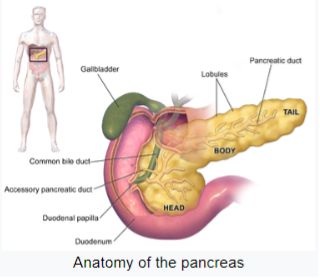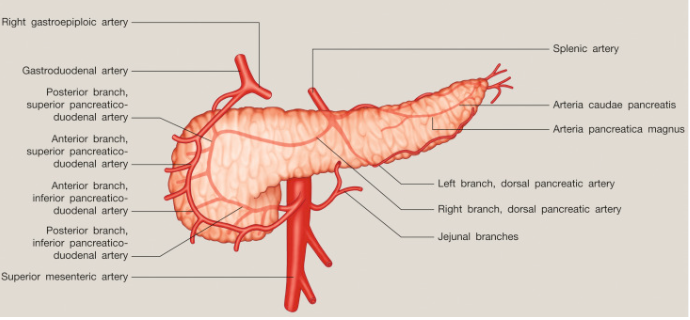Pancreas Cancer
The pancreas is an organ located in the retroperitoneal area that is involved in both digestion and the functions of the endocrine system.
The pancreas is an endocrine and exocrine organ. While endocrine secretions are hormones such as insulin, glucagon, somatostatin, exocrine secretions includes:
Amylase: Converts carbohydrates such as starch and glycogen into disaccharides and trisaccharides)
Lipase: Converts neutral fats into small building blocks, fatty acids and monoglycerides.
Phospholipase A2 and phosphatase: provides hydrolysis of fatty acids.
Colipase; It has a role in protecting lipase, which is the other enzyme secreted, from bile acids.
Trypsinogen; It provides the breakdown of peptides, which are the building blocks of amino acids, and the activation of all other pancreatic enzymes.
Chymotrypsinogen Elastase ; It plays a major role in digestion by releasing many enzymes, including carboxypeptidases A and B.
Anatomy
No other organ in the abdomen is surrounded by so many anatomical structures as the pancreas. It is surrounded by structures such as duedonum, stomach, spleen, left kidney, left adrenal, transverse mesocolon, right ureter and jejunum.

Anatomical parts; Uncinat process , neck, body and tail. Lesions in the pancreas may involve one or two of these parts. The surgical procedure for the lesions in the head and uncinate part differs from the lesions involving the body and tail part.

Arteries
It has a complex nurturing system like Splenic artery originating from the celiac artery and Dorsal Pancreatic artery arising from it and Transverse pancreatic artery which is its continuation, Greater pancreatic artery and caudal pancreatic artery, Gastroduedonal artery originating from the Hepatic artery and Anterior and Posterior Superior Pancreaticoduedonal artery arising from it, the Posterior Inferior Pancreaticoduedonal artery. Arterial nutrition is followed by the venous system.

LYMPHATIC SYSTEM
It consists of Superior Nodes, Inferior Nodes, Anterior Nodes, Posterior Nodes and Splenic Nodes. As in every cancer surgery, while cancerous area is being removed, all of the lymph node structures draining that area should also be removed together with the piece.
PANCREATIC CANCER
There are benign, intermediate and malign tumors.
- World Health Organization Classification
- Benign Tumors
- Serous cystadenomas
- Mucinous Cyst Adenomas
- Intraductal papillary-Mucinous Cystadenomas
- Teratomas
- Borderline Tumors
- Mucinous Cystic Tumor (Moderate Dysplasia)
- Intra-Canal Papillary-Mucinous Tumor (Moderate Dysplasia)
- Solid Psodopapillary Tumor
- Malign Tumors
- Ductal Adenocarcinoma
- Mucinous Non-Cystic Cancer
- Signet Ring Cell Carcinoma
- Adenosquamous Carcinoma
- anaplastic carcinoma
- Mixed Ductal-Endocrine Carcinoma
- Serous Cystadenocarcinoma
- Intraductal Papillary Mucinous Carcinoma
- Acinar Cell Carcinoma
- Acinar Cell Cystadenocarcinoma
- Mixed Acinar-Endocrine Cancer
- pancreatoblastoma
- Psodopapillary Carcinoma
Symptoms In lesions involving the head of the pancreas;
- Weight Loss (90%)
- Jaundice (80%)
- pain surrounding the abdomen (70%)
- anorexia (65%)
- dark urine (60%)
- Steatorrhea (60%)
- Itching (40%)
- Fatigue (35%)
In lesions involving Body and Tail of the Pancreas;
- Weight Loss (100%)
- Pain (90%)
- Fatigue (43%)
- Vomiting (43%)
- Anorexia (33%)
- Melena (17%)
- jaundice (7%)
Diagnosis
- Laboratory Tests (Total Bilirubin, ALP, GGT, Prothrombin Time and some biochemical tests)
- Tumor markers ( CA-19-9, CA-125, CEA, ..)
- Whole Abdominal Ultrasonography
- Computed Tomography
- Magnetic resonance Imaging (MR)
- Endoscopic Retrograde Cholangiopancreatography (ERCP)
- Percutaneous Transhepatic Cholangiography (PTC)
- Endoscopic Ultrasonography (EUS)
- Laparoscopy
TREATMENT
Distal Pancreatectomy (In Body and Tail Lesions)
Pancreatoduodenectomy (Whipple Surgery) ( In Pancreatic head, Uncinat area , Duedonum and Ampulla vateri masses)
Total Pancreatectomy

In some cases, masses in the pancreas may invade adjacent vessels. In these cases, it is very important for the surgeon to have vascular surgery experience. Reconstruction by removing the vessel in which the tumor invaded is vital for the patient’s life when necessary.
Superior Mesenteric Vein Invasion and Radical Lymph Node Excision
Portal Vein Invasion and Reconstruction
Portal Vein Invasion and Reconstruction
Portal Vein Reconstruction
Sometimes tumors may invade the surrounding organs by making local invasion. In such cases, Unblock surgical resection may be required in local neighbor metastases.
(Total Pancreatectomy, Splenectomy, Partial Gastrectomy, Duedonectomy, Cholecystectomy, Segment 5 Liver resection, Extended Right Hemicolectomy) A pancreatic cancer surgery was performed under High Spinal and Epidural Anesthesia in conversation with the patient during the operation, which is the first in the world, Operation lasted 6 hours)
Get Free Quote